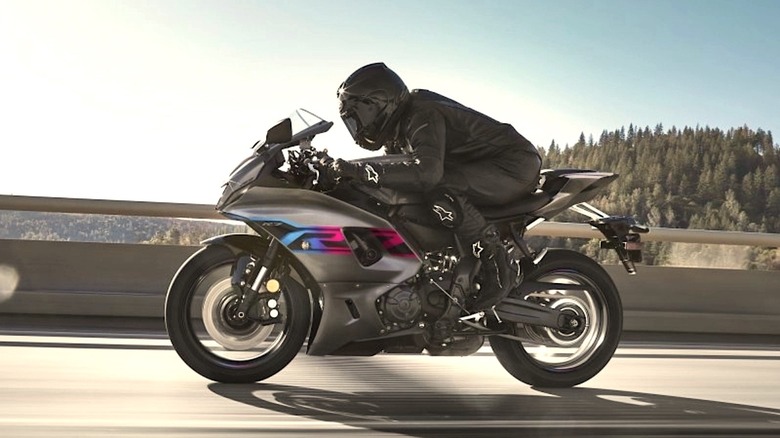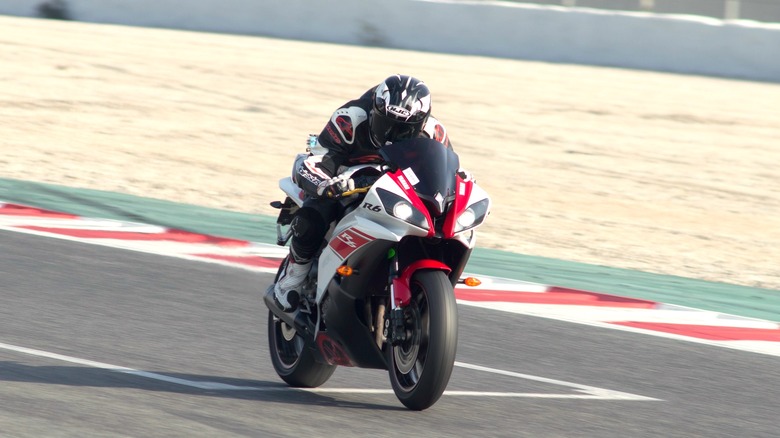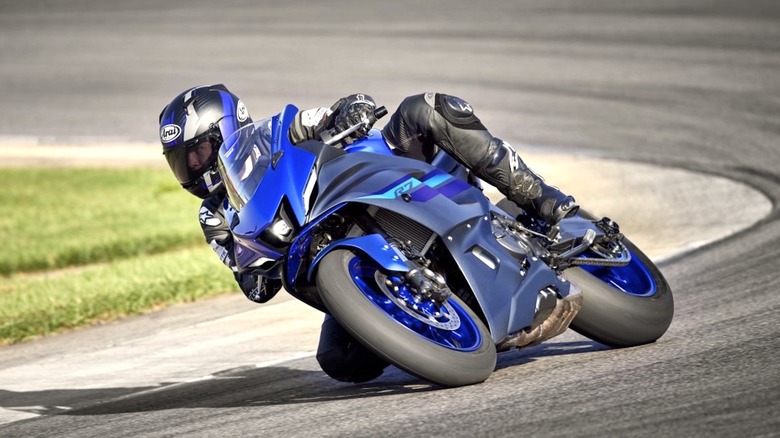Yamaha R6 Vs. R7: Which Bike Is Faster & How Do The Engines Compare?
Whether manufacturing pitch-perfect pianos or high-performance motorcycles, Yamaha has developed a reputation for precision and quality in the century-plus since the company was founded. But even as impressive as the company's contributions to the world of music have been, one could argue that Yamaha is better known for cranking out some of the fastest bikes on the roads and raceways of the world.
Some of the more celebrated builds to grace Yamaha's vaunted lineup come from the manufacturer's wide-ranging R Series, including the YZF R6 and more recent YZF R7. Since those bikes rolled off the production line, Yamaha has deemed them worthy of use by everyday consumers on the freeway as well as on the race track, with each build having managed to leave a distinctive mark on every blacktop they've encountered.
Given the obvious similarity in their design, as well as the closeness of the bikes' name and number designations in the Yamaha lineup, the R6 and R7 can be hard to tell apart to the naked eye, but the builds boast significant differences. Primarily, they are powered by engines that produce noticeable changes in their power outputs, with the YZF R6 being considerably faster, even as the YZF R7 is powered by a bigger engine. Here's a closer look at how these Yamahas stack up in regards to their speed capabilities and the size of the engines powering them.
The R6 is the faster of the two Yamahas
Yamaha doesn't disclose the certified top speeds of their bikes on their site, so we'll be relying largely on numbers provided by other trusted outlets. However, when it comes to speed, the exploits of the YZF-R6 are pretty much legendary, so Yamaha fans likely don't need much of a history lesson about its road and track devouring ways. Indeed, the decidedly not-for-beginners build has ranked among the fastest Yamaha has ever produced since its 1999 introduction, and the bike has become a force to be reckoned with on the world racing scene, with riders piloting the YZF R6 netting 10 WorldSSP Championship's since 2000.
Given those credentials, it should come as no surprise that the R6 is considerably faster than the modern version of the R7, with Motorcycle News claiming to have topped an R6 out on at a speed of 165 mph in its own tests. But even as incredible as the R6 top speed is, it's topped by the 170 mph reached by Yamaha's short-lived original YZF R7, which also hit the scene in 1999. As for the newer version YZF R7, the modern take on the build would almost certainly not be able to catch its counterpart on an open track. However, the bike can easily top the 100 mph mark on a straightaway, and in their independent tests, Motorcycle News notes they were able to push the R7 up to 120 mph, further claiming that 130 mph is likely even attainable in the right conditions.
The R7 boasts the bigger engine
To be clear, the YZF R6 may be a little harder to come by on the open market, as Yamaha ceased production on the speedy build after the 2020-2021 model year. Though there is still a track-only option available to U.S. riders, the decision to limit R6 production was driven by a combination of poor sales, and dramatically altered emissions regulations for motorcycles in the European Union.
The engine powering Yamaha's modern YZF R7, however, meets those strict European regulations, and it's done so despite a step up in displacement over the one powering the R6. That's right, when the R7 hit the streets in 2022, it did so outfitted with a four-stroke, liquid-cooled, DOHC inline twin-cylinder engine with 689 cc displacement. But in their independent road tests, Motorcycle News charted the R7's engine power credentials at just 72 hp, and that number is a dramatic step down from Yamaha's YZF R6, whose output can be almost double depending on the model year. Even still, the power downgrade likely makes the R7 a little easier to handle for less experienced riders.
As for the R6, it sped onto the world's racetracks and roadways powered by a smaller displacement engine in its 599cc DOHC liquid-cooled four-cylinder model. Displacement aside, the R6 packs a bit more punch on the power front, with Motorcycle News claiming that Yamaha's engineers managed to kick the ponies up to 116 hp, with the engine delivering torque up to 45.5 pounds-feet, giving the bike an obvious edge over the R7 in terms of both speed and raw power.


